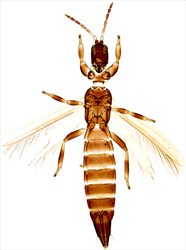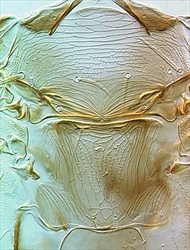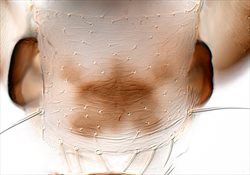
Female

Head & pronotum

Head

Antenna

Antenna

Antennal segments II–IV

Meso & metanota

Pronotum

Female sternite VII

Fore wing
Both sexes fully winged. Body, legs and antennae largely brown, pronotum usually yellow, also tarsi, apex of tibiae and base of mid and hind femora; antennal segment II yellow in contrast to segment I, segment III pale at base; fore wing pale with posterior margin weakly shaded. Antennae 9-segmented, VII–IX forming a unit, segments III–IV with irregular transverse sensorium at apex and a longitudinal row of 1 or 2 sensory areas ventrally. Head longer than wide, with 8 or more pairs of small ante-ocellar setae; inter-ocellar setae prominent, arising on anterior margin of ocellar triangle; postoccipital region reticulate. Pronotum with 1 pair of long posteroangular setae, 4 pairs of posteromarginals. Mesonotum with microtrichia on transverse sculpture lines. Metanotum with linear reticulate sculpture bearing microtrichia, median setae near posterior margin. Fore tarsus with strongly recurved hamus. Fore wing with cross veins faint. Abdominal tergites weakly sculptured, trichobothria on X about as large as major setal bases. Sternites III–VI with 2 or 3 pairs of posteromarginal setae, lateral pairs arise submarginally; sternite VII with 4 pairs of posteromarginal setae, 2 pairs of accessory setae, and 3 pairs of discal setae laterally.
Six species are recognised in the genus Rhipidothrips, although only brunneus and gratiosus are widespread in Europe. Two species are known only from south-eastern Europe, one from the Canary Islands, and one is recorded from Finland and France (zur Strassen, 2003). The two species found in Britain are distinguished by the colour of antennal segment II, the number of posteromarginal setae on the pronotum, and the row of sensoria ventrally on antennal segments III and IV in gratiosus.
Presumably phytophagous on various Poaceae, especially cereal crops, Avena, Hordeum and Triticum. However, in California, Bailey (1954) recorded this species as presumably predatory on other thrips, but there seems to be no evidence for this among populations in Europe.
In Britain, known only from various sites in southern and south eastern England before 1936, no further north than Oxfordshire (Morison, 1947-1949; Mound et al., 1976). This species is widespread in southern areas of the western Palearctic as far south as Iran, and is also known from California.
AEOLOTHRIPIDAE
Rhipidothrips gratiosus Uzel
Rhipidothrips gratiosus Uzel, 1895: 67
Rhipidothrips uzelianus Bagnall, 1934: 482
Bailey SF (1954) A review of the genus Rhipidothrips Uzel (Thysanoptera: Aeolothripidae). Pan–Pacific Entomologist 30: 209–220.
Morison GD (1947-1949) Thysanoptera of the London area. London Naturalist, Supplement 26: 1–36; 27: 37–75; 28: 76–131.
Mound LA, Morison GD, Pitkin BR & Palmer JM (1976) Thysanoptera. Handbooks for the Identification of British Insects 1 (11): 1–79.
zur Strassen R (2003) Die terebranten Thysanopteren Europas und des Mittelmeer-Gebietes. Die Tierwelt Deutschlands 74: 1–271.